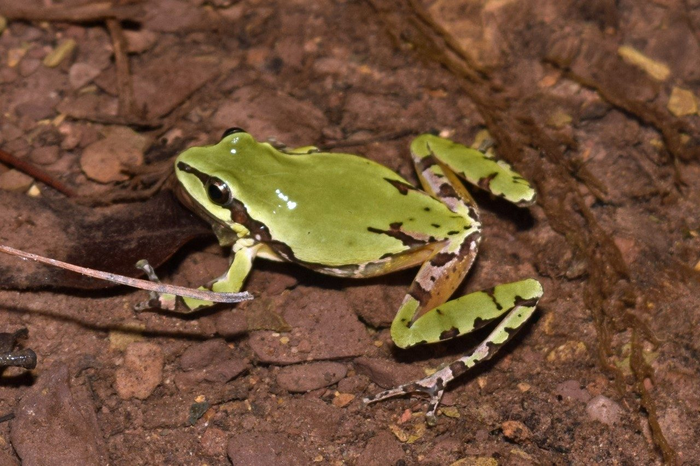Virginia Tech biological sciences postdoctoral researcher Traci DuBose wants to ensure no frogs or toads land below conservationists’ radar.

Credit: Virginia Tech’s Meryl Mims
Virginia Tech biological sciences postdoctoral researcher Traci DuBose wants to ensure no frogs or toads land below conservationists’ radar.
For the last two years, DuBose has been measuring the intrinsic sensitivity of species to climate change — a key determinant of extinction vulnerability — in 90 species of anurans, commonly known as frogs and toads. By accessing publicly available data, DuBose and her team evaluated and compared more than 140,000 observations of anurans native to the contiguous United States, making it the first study of this size and scope.
“The United States is home to over 100 species of frogs and toads,” said DuBose, a researcher in the Mims Lab at Virginia Tech led by Meryl Mims, associate professor in the Department of Biological Sciences in the College of Science. “Frog and toad species are great study animals because they live in so many different areas like deserts, marshes, and forests and are very charismatic.”
But how does one measure rarity? That’s where the benefit of the 140,000 observations come into play. These occurrences hold the key to three important items: what type of animal, as well as when and where the animal was spotted.
Mims said she is optimistic about the scope of DuBose’s study and looks forward to building upon its momentum through the continued support from the U.S. Geological Survey.
Equally, DuBose is excited to bring conservation partners into the fold, by using apps to document and share point occurrences, especially if it’s a frog or a toad. “In this scenario, everyone wins,” said DuBose. “Community scientists who added points to iNaturalist, for instance, can know their data is helping inform species conservation.”
# # #
In 2019, the Mims Lab at Virginia Tech was awarded additional funding from the U.S. Geological Survey. In this capacity, the lab works closely with the organization’s scientists to understand species vulnerability to climate change, with regular meetings and collaborations on projects, publications, and science communication products.
The research team capitalized on the two billion occurrence records of Global Biodiversity Information Facility (GBIF) data, which is free and provides open access to biodiversity data that details when and where a species is observed. It serves as an international network and data infrastructure funded by the world’s governments.
“GBIF was a game changer for us as it allowed us to include and compare many species directly with one another in ways not currently captured by most conservation status designation approaches,” said DuBose.
Amphibians worldwide are affected by climate change and potentially one of the most threatened. DuBose and her team found that some species of amphibians are more likely to be sensitive to climate change because they are not protected by state or federal regulations. The team determined that approximately 11 percent of anuran species are sensitive to climate change, but are not currently listed as at-risk either at the state, federal, or international levels.
For example, the cliff chirping frog and Brimley’s chorus frog are geographically rare and inhabit areas that will likely be threatened by shifting climate, such as deserts and coasts, respectively.
The team also identified eight additional anuran species that are overlooked at the international and/or federal levels.
Helping overlooked species is also a passion of Mims.
“Climate change is known to threaten many species worldwide, but we often lack tools and approaches to compare the vulnerability of many species at once, particularly for species with limited data available,” said Mims, who is also an affiliated faculty member in Fralin Life Science Institute’s Global Change Center. “This may leave some species overlooked, making efficient conservation planning and action difficult.”
The Rarity and Climate Sensitivity Index tool, developed by the Mims Lab and U.S. Geological Survey partners, uses the concept of rarity to estimate extinction risk. A species that occurs in few places and in a narrow temperature and precipitation zone is more at risk of extinction.
“Our approach provides a useful tool for managers to identify species that may be flying under the conservation radar and serves as an early warning system to identify overlooked, at-risk species,” said Mims.
And by charismatic, DuBose said that people recognize both frogs and toads and hear them at dusk. “They might have good memories associated with them.”
As a result of this research, DuBose was the lead author of a paper, “Mismatch between conservation status and climate change sensitivity leaves some anurans in the United States unprotected,” recently published in Biological Conservation, a leading international journal in the discipline of conservation science.
Globally, 41 percent of amphibians are threatened by anthropogenic changes, such as those made by people, to the landscape, based on assessments by the International Union for the Conservation of Nature Red List. This includes disease, invasive species, habitat loss, and climate change. Climate change vulnerability is defined in part by characteristics that govern a species’ susceptibility and capacity to persist in place through shifts in temperature, precipitation, and other environmental variables.
But even in regions with relatively high data availability, such as the United States, a systematic, multispecies assessment of the intrinsic sensitivity of anurans to climate change is lacking, which may leave some vulnerable species overlooked.
DuBose and her team’s research builds on an initial faculty seed grant awarded in 2018 by the Global Change Center to study species vulnerability. Co-authors on the paper, Sam Silknetter, Chloe Moore, Grace O’Malley, are all Interfaces of Global Change fellows through the Interdisciplinary Graduate Education Program, as well as recent graduate Tess Alexander, who was supported by a Global Change Center Undergraduate Research Award.
Journal
Biological Conservation




